Our March 20, 2014 cruise down the southeast coast of South Bruny Island, Tasmania, continued as Eileen, Ryan and I, warm in our red waterproofs, watched for scenery, geology and wildlife.
As I explained in Part 1, our boat took us from the low coastlines of Adventure Bay...
... past a palisade of sea cliffs - some of the highest in the world - pockmarked with wave-worn caves.
Great columns of dolerite, the stuff of which the cliffs are made, recalled the basalt pillars of the Giant's Causeway that Eileen and I had seen on the other side of the world, in Northern Ireland.
Tufts of tussock grass grow on the upper reaches of the cliff, between the eucalypt scrub above and the waves below.
Isolated columns of dolerite, eroded out from the main cliffs, rose as stacks emerging from the sea. This famous example, known as the Bruny Stack or, more simply, as The Monument, is thirty metres high. The cruise boats make a great deal out of driving, at high speed, between The Monument and the cliffs behind it.
The other famous (and much-photographed) landmark along the Bruny island cliffs is a spectacular blowhole.
Blowholes, unlike sea stacks, have the advantage (for viewers with short attention spans, including small children) that they are ever-changing (and noisy).
Past the blowhole, we continued south, past guano-streaked colonies of Black-faced Cormorants (Phalacrocorax fuscescens)...
... and natural arches carved in the rock.
Closer to the southern end of the island, the cliffs once again gave way to low, eucalypt-covered rocky shores....
...or broke up into a series of tiny islets, out at sea to the east.
This was the domain - at least, outside the breeding season - of the Australian Fur Seal (Arctocephalus pusillus doriferus) [the nominate subspecies, A. p. pusillus, is the common fur seal of South Africa, where its numbers may be ten times those of the Australian population]. We spent a fair bit of time cruising the seal rocks, at spectacularly close range.
Though they breed further north, mostly on islets in Bass Strait, at other times of the year male and female fur seals haul out on the rocks of South Bruny.
The sexes, like those of most sea lions, differ considerably in size; the impressively bear-like bulls can weigh up to 360 kg (as opposed to 120 kg for females). These are animals best seen from a safe vantage point (a boat, for instance).
Unlike the Northern Fur Seal (Callorhinus ursinus), an animal I saw many years ago on Alaska's Pribilof Islands, male Arctocephalus fur seals do not collect females into a harem and guard them against all comers. Instead, they fight over territories on the breeding grounds, and the females come and go within these territories as they please.
At haulouts, though, the animals pretty much arrange themselves higgledy-piggledy, bulls and cows together. In some areas they may be joined by other species of fur seal; I was told that on rare occasions a New Zealand Fur Seal (Arctocephalus forsteri) shows up here too, but there were no obvious ones there on our visit (the two species are hard to tell apart). Tasmania's comparatively few New Zealand Fur Seals usually haul out on its southern and western coasts.
You might not guess it from looking at these pictures, but (according to the Handbook of the Mammals of the World) Australian Fur Seals are not supposed to be particularly gregarious animals. Perhaps the lack of haul out space forces them into closer proximity than they might prefer?
Nonetheless, we did find a few individuals lounging in solitary splendour; there certainly seemed to be room for more animals here, so perhaps these individuals were particularly unsociable.
Besides, the seals were surprisingly agile climbers. They seemed to have no difficulty reaching the higher ledges. We saw a few perched atop high and jagged pinnacles, looking like misshapen Landseer stags. We could only wonder how they got there.
At the other extreme, animals were constantly slipping in and out of the water.
We were surrounded by an assortment of swimmers, some of whom seemed to be in the sea solely to get a good look at us, or (like the back-swimming, open-mouthed individual in the lower photograph) for the sheer pleasure of it. Notice, by the way, the protruding ears on the animal in the upper photo - one of the more obvious ways to tell members of the fur seal and sea lion family (Otariidae) from the 'true' seals (Phocidae), which lack external ear, have their hind limbs joined together, and are far less agile on land.
Yes, the seals were noisy and smelly, as both Ryan and Eileen remarked. They were also magnificent, and (considering how intensively we humans hunted them up to as late as 1970) we were lucky to encounter them, even briefly, on such close terms.
The seal rocks were the climax of our cruise. From here we headed out to sea, past islets whitewashed by generations of Black-faced Cormorants, for a relatively quick run back to Adventure Bay. Our only real regret was that the dolphins that usually show up on these trips heard we were coming, and stayed away.
Back on land, as we got ready to drive back to Hobart, we admired the candy-coloured blossoms of Eucalyptus leucoxylon - undoubtedly planted here, as the species is not native to Tasmania....
...and a male Flame Robin (Petroica phoenicea), the only one we were to see on our trip, dancing about on the booking office lawn.
So if you go to Tasmania, should you put this trip on your list of things to do? We would certainly say yes (even if the dolphins only showed up on the company poster). And no, I didn't get a discount for promising to say that. Here is their web site. Take a look, if only for the terrific aerial photo of the whole stretch of southeastern cliffs - a photo that may say more about why you should do this than my two lengthy blog entries!





















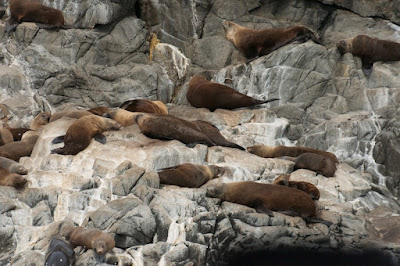








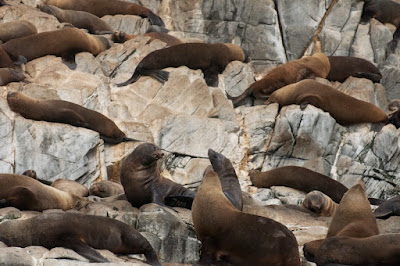
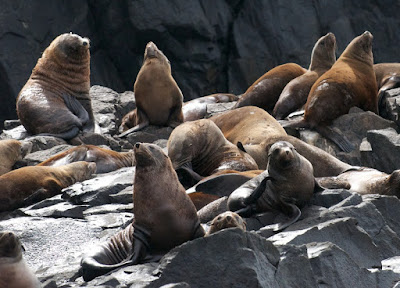





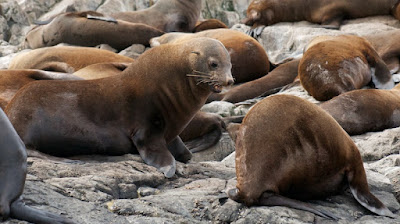
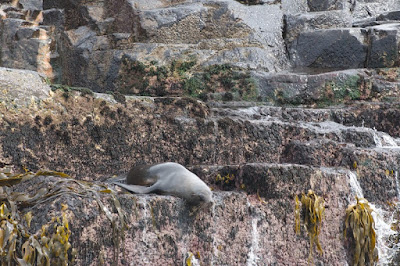













No comments:
Post a Comment